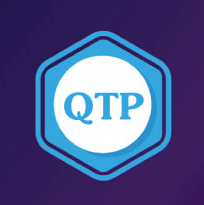QTP Tutorial

In general, the term QTP stands for Quick Test Professional, and nowadays, it is also known as UTF or Unified Functional Testing. It is generally considered to be an automated functional testing tool that helps testers while performing regression testing. However, it is considered one of the most advanced tools as it does not require the tester's attention all the time, or we can say in simple words that it does not force them to keep an eye always. In addition, it is capable of working automatically as soon as the tester completes the script, which we will discuss later in this tutorial. Typically, UTF uses Visual Basic scripts to automate certain types of applications, and sometimes this type of script is also abbreviated as VB script.
Testing Tools
Testing tools from a software testing context can be categorized as a product that usually supports one or more test activities right from planning, requirements, creating a build, test execution, defect logging, and test analysis. Let us see some other key factors on which the testing tools are usually classified.
Classification of Tools
In general, Testing Tools can be classified based on several parameters. Some of them are as follows:
- Purpose of the tool
- Activities that are supported within the tool
- The type/level of testing it supports.
- The kind of licensing (open source, freeware, commercial)
- The technology used
Where is QTP Used?
QTP is a functional testing tool, as we have discussed earlier, which is best suited for regression testing of certain types of applications. It has several versions, such as the licensed, commercial version, and is considered one of the most popular tools available on the market. If we talk about its working, it usually compares the actual and the expected result and reports the results in the execution summary.
QTP - History and Evolution
It was originally owned by Mercury Interactive, and after some time, it was acquired by HP. Its original name was Astra Quick Test, later which was renamed as Quick Test Professional. However, the latest version of it is now known as Unified Functional Tester. Lets us see some of the major advantages or benefits over several other tools.
Now let us take a look at the version history of QTP.
| Versions |
Dates |
| Astra Quick Test v1.0 to v5.5 - Mercury Interactive |
May 1998 to Aug 2001 |
| QuickTest Professional v6.5 to v9.0 - Mercury Interactive |
Sep 2003 to Apr 2006 |
| Hp-QuickTest Professional v9.1 to v11.0 - Acquired and Released by HP |
Feb 2007 to Sep 2010 |
| Hp-Unified Functional Testing v11.5 to v11.53 |
2012 to Nov 2013 |
| Hp-Unified Functional Testing v11.53 to v 14 |
31 Jan 2017 |
Features of the latest version of QTP/UFT
The following are some of the features provided in the latest version of QTP/UFT (Unified Functional Testing).
|
Latest Features |
Details |
| 1. |
Browsers supported by QFT : |
- Supports Windows 8.1 and Windows Server 2012
- Performs testing on Safari browser
|
| 2. |
UFT extension in Chrome store |
Receive updates automatically on chrome |
| 3. |
Support for windows runtime objects |
- Record and run tests on your Windows Runtime application
- Create object repositories with Windows Runtime application
|
| 4. |
Newly supported technologies |
SAP Web Dynpro ABAP for NetWeaver 7.40 and so on
|
| 5. |
Extended support for various technologies |
- Recognizes and interacts with objects from Siebel web applications, SAP applications, etc.
- New flexible test object methods available for advanced data grid controls
|
Advantages
- Developing automated tests using VBScript does not require a highly skilled coder, which is relatively easy compared to other object-oriented programming languages.
- It supports popular automation frameworks- keyword-driven testing approach, modular testing approach, data-driven testing approach, etc...
- Typically, it uses an active screen to record scripts and helps the tester in referring to the screen object properties.
- Readily Integrated with Test Management Tool (Hp-Quality Center), which enables easy scheduling and monitoring.
- Since it is an HP product, full support is provided by HP and by its forums for addressing and solving technical issues.
- It supports different add-ins like Oracle, Java, SAP, NET, Web Forms, People soft, etc.
- It also allows users to enhance the existing tests even without the AUT through an active screen.
- It can be integrated with Test management tools like Quality Center, Test Director, and Winrunner.
- Different types of suites like Smoke, Regression, Sanity can be easily maintained.
- It can be integrated with Test management tools like Quality Center, Test Director, and Winrunner.
- Different types of suites like Smoke, Regression, Sanity can be easily maintained.
- Easy to use, ease of navigation, results validation, and Report generation.
- It has an excellent object identification process or mechanism.
- Test reporting is possible through QTP for analysis purpose
- It can also be used for Mobile Application Testing purposes.
- It also supports record and playback.
- It comes with an inbuilt IDE.
- It supports XML
- Last but not least, it is quite easy to maintain.
Disadvantages
Now lets us see some of the major disadvantages of the QFT
- Unlike Selenium, QTP works in Windows operating system only.
- Until now, not all versions of Browsers are supported, and the testers need to wait for the patch to be released for each one of the major versions.
- Having said that, it is a commercial tool, and the licensing even though it costs too much.
- However, the scripting operation required very little time of the testers; even after that, the execution time is relatively higher as it puts the load on the CPU & RAM.
|

 For Videos Join Our Youtube Channel: Join Now
For Videos Join Our Youtube Channel: Join Now










